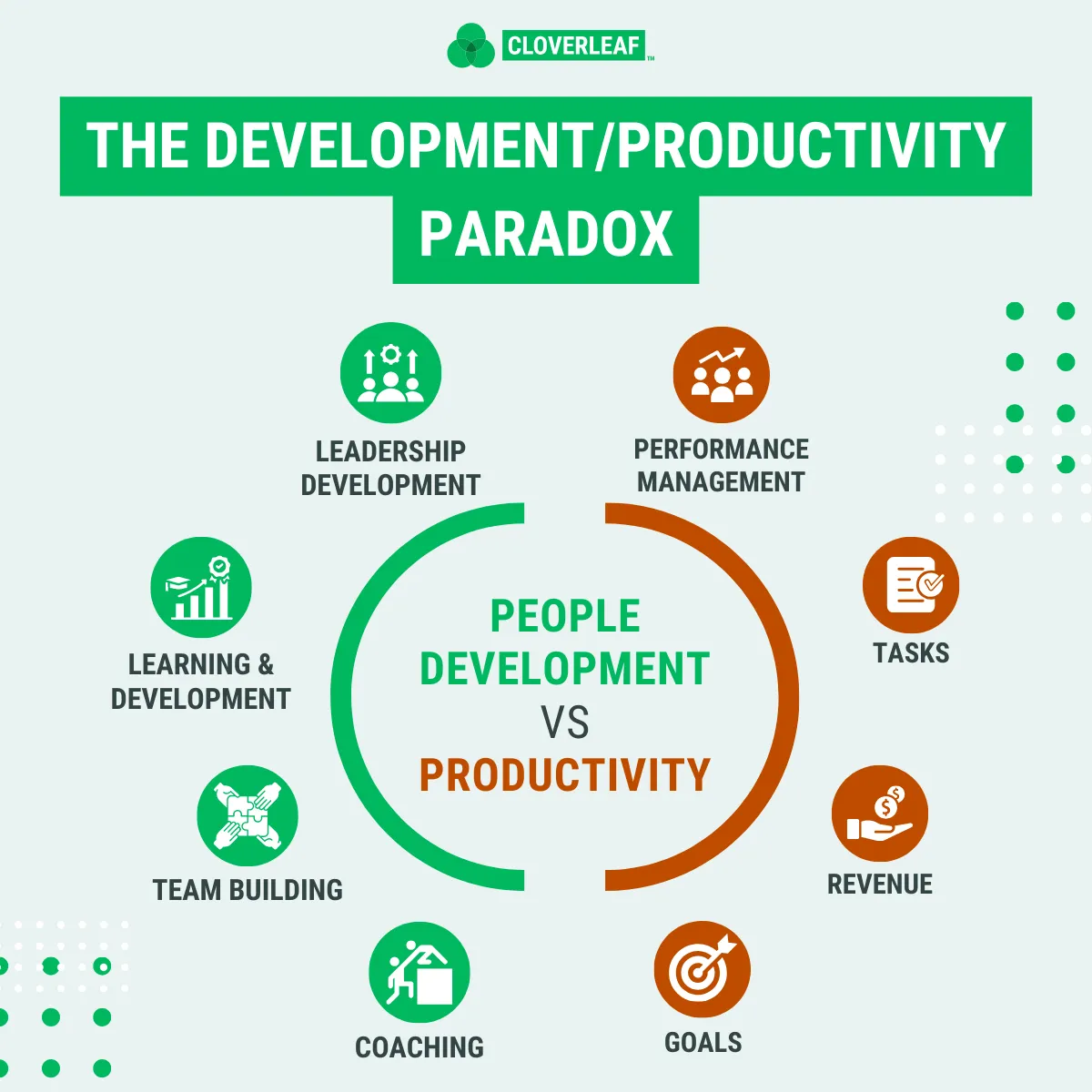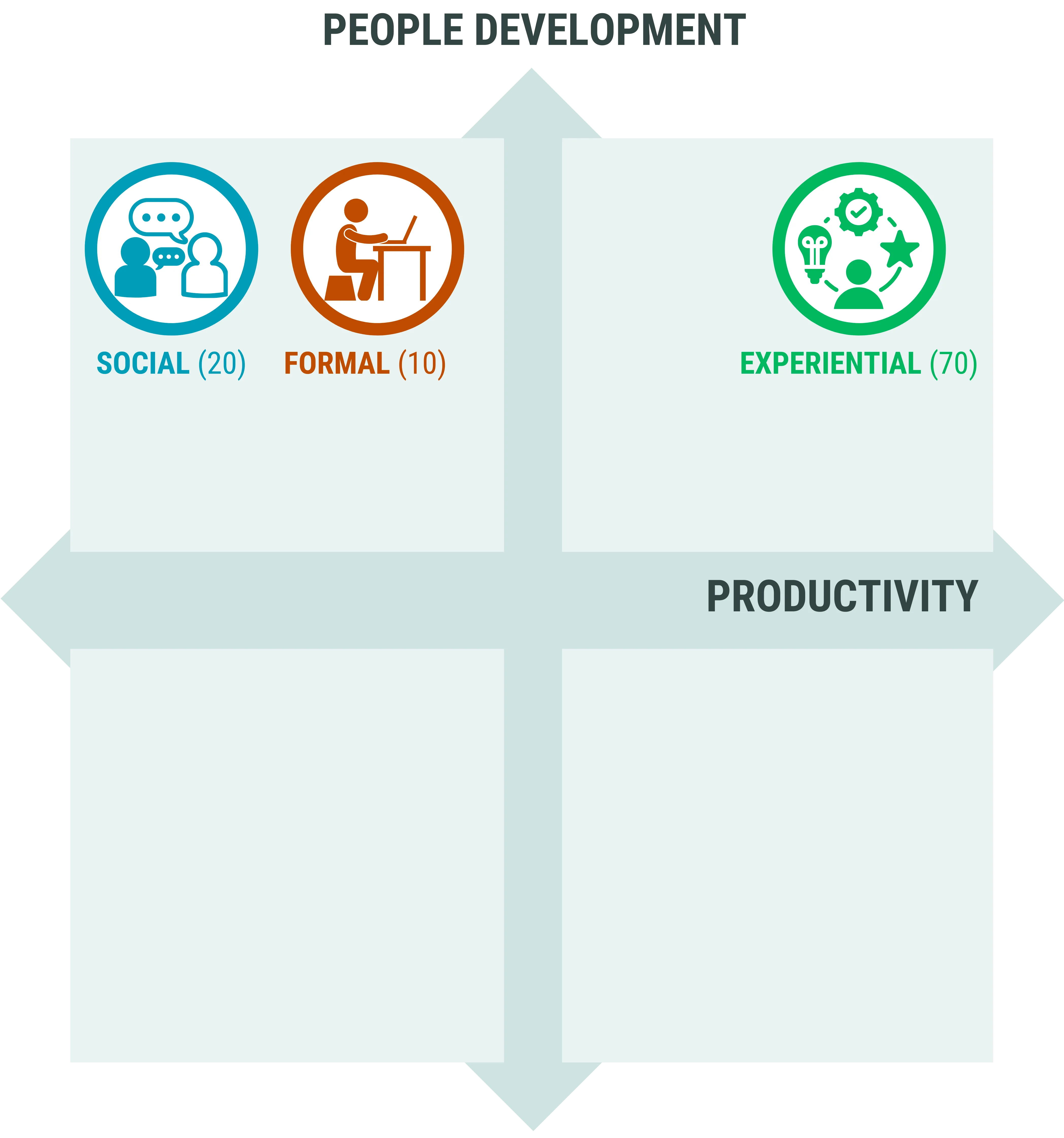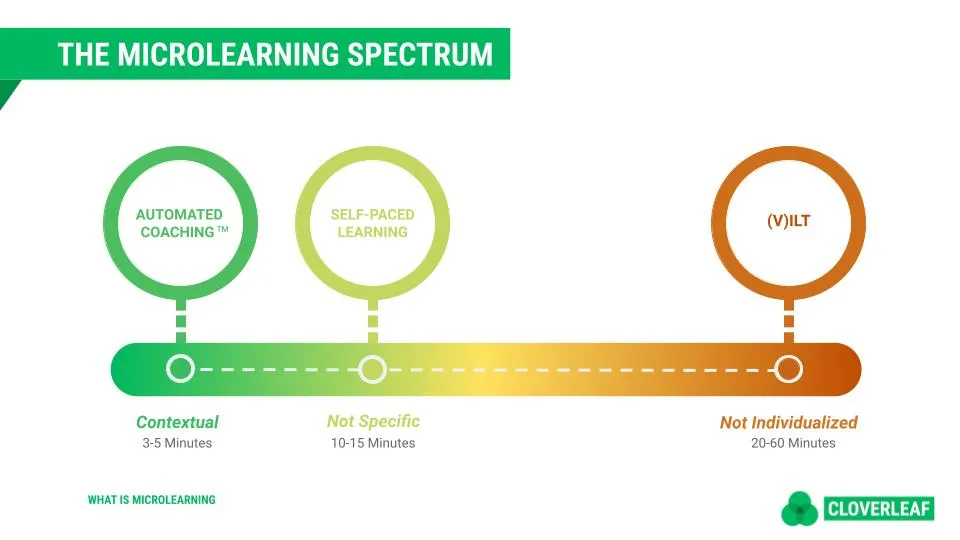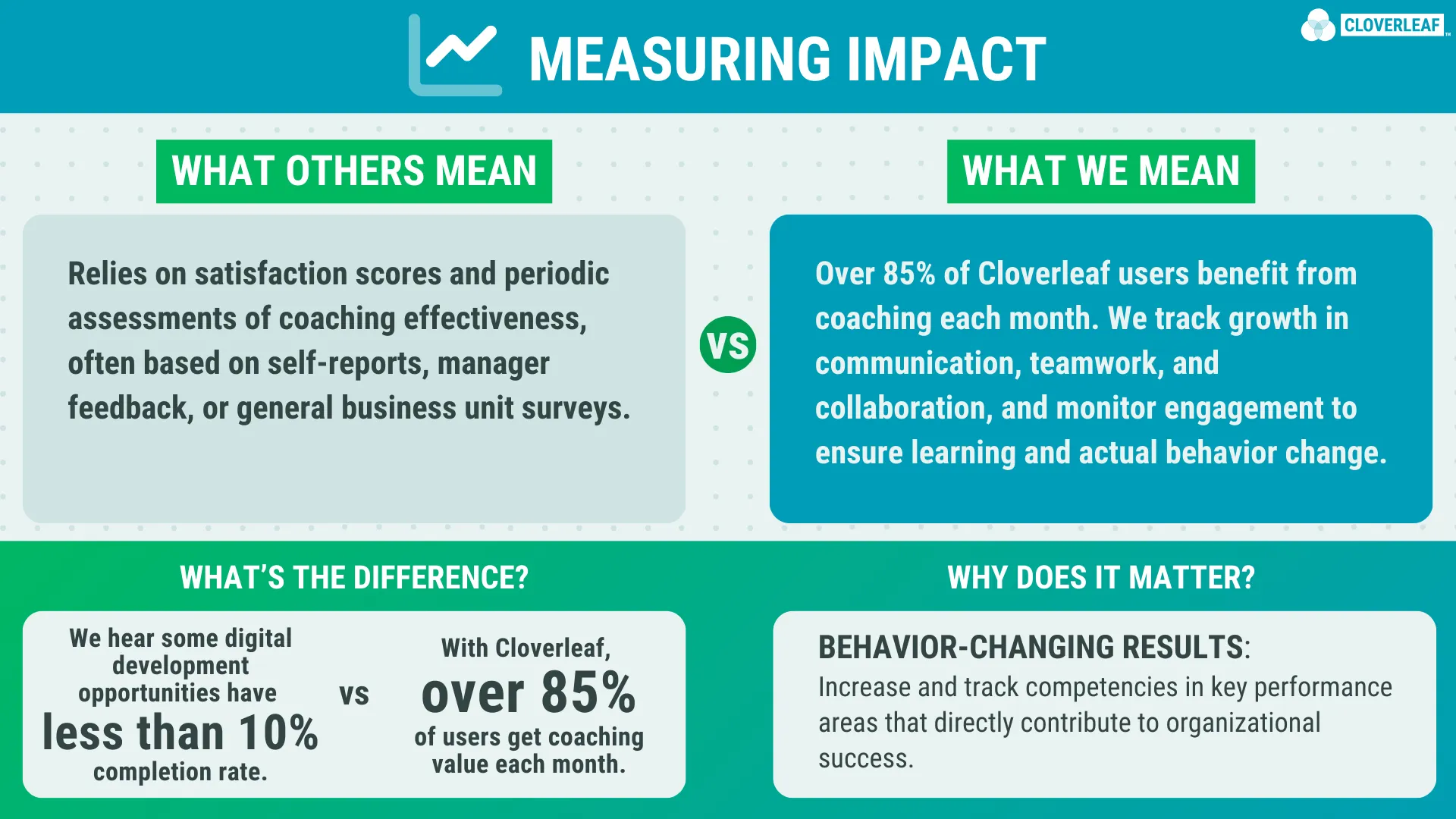People development is no longer a matter of simply offering training sessions. Today’s leaders face a more complex challenge: building stronger teams while proving the ROI of these initiatives, all without sacrificing productivity. With traditional training methods struggling to keep up, the challenge is no longer just about offering learning opportunities but integrating them into everyday work in a way that drives measurable outcomes.
For example, consider companies that invest heavily in leadership workshops but struggle to see these skills applied on the job. This gap between training and real-world application leads to stagnant growth and missed opportunities. Employees are left juggling development and productivity as two opposing forces, often feeling that time spent learning pulls them away from their responsibilities.
What is the real challenge? Training disconnected from daily work feels like a waste to participants and upper level leaders.
Organizations need strategies to improve performance faster. Adding more training sessions is rarely the answer; it often comes down to embedding practical guidance into the flow of work so development happens when it’s needed most—on the job, in real time.

The Productivity vs. People Development Paradox
One of the toughest challenges for Talent Development leaders is the constant pull between getting work done and helping teams grow. High performance is always expected, but so is developing your people. This creates a paradox: time spent learning can result in time lost on the job.
Workshops, one-on-one coaching sessions, or LMS can struggle to bridge this gap. While they can help provide valuable learning, these insights can seem abstract and disconnected from an individual’s daily responsibilities. As a result, people walk away with great ideas but rarely get the chance to apply them where they’d have the most impact.
Research shows that growth happens when development isn’t at odds with productivity. The 70-20-10 model shows that learning is most applicable when relevant and contextual to one’s work. The 70-20-10 Model indicates that 70% of learning is experiential—in other words, it happens through doing. Another 20% comes through social interactions like mentorship or team discussions, and only 10% is formal. Yet, most traditional programs focus too heavily on that 10%, missing out on the opportunity to make development relevant to daily work.
How much time and budget are wasted on programs and training models that don’t lead to meaningful improvements in team performance? The cost isn’t just lost time—it’s reflected in low engagement, high turnover, and missed growth opportunities.
Ready To Scale People Development In Your Organization?
People Development Strategies Are Evolving
Workshops, formal training, and one-on-one coaching have their place but can struggle to match the speed and complexity of modern work environments. People need support that speaks directly to their work challenges. Teams face people problems, difficult feedback conversations, or collaboration issues that can’t wait for scheduled training sessions.

What If Development and Work Do Not Have to Compete As Opposing Forces?
Forward-thinking organizations have realized that pulling employees away from their daily responsibilities for formal training is not a one-and-done solution. Instead, development needs to happen where the work happens.
By embedding personalized coaching into employees’ daily routines, companies can ensure that learning is relevant and immediately applicable, driving growth and performance without disrupting productivity.
Effective development cannot happen by squeezing learning into downtime—instead, it should partner with work through practical, actionable learning. Teams need in-the-moment guidance that directly addresses the challenges they’re facing.
It’s not about theory—it’s about helping individuals solve the problems they’re tackling right now, whether it’s managing team dynamics, navigating a tough conversation, or preparing for a project. Providing this kind of actionable support makes development practical and results-driven.
Picture this: a manager preparing for a difficult conversation receives a personalized tip a few hours before the meeting, helping them adjust their approach. It’s fast, easy, and directly impacts the outcome of that interaction. This kind of support not only builds better skills but does so without pulling people away from their work.
When development becomes a natural part of daily tasks, its impact grows exponentially. An integrated approach ensures that development directly influences employee growth and team performance to soften the tension between learning and productivity.

Microlearning Tools To Build Skills in the Moment
Microlearning addresses a critical gap in traditional development. Waiting for scheduled sessions often means teams miss out on immediate solutions to pressing challenges. Teams facing conflicts, feedback issues, or urgent decision-making can’t afford delays. In these fast-paced environments, learning that happens on demand and in direct response to current problems is vital.
For example, an employee dealing with a tough client interaction can’t wait for a quarterly workshop on communication—they need help managing the situation effectively. Microlearning shines in these instances. It integrates learning directly into workflows, providing timely solutions that drive quick decision-making without interrupting productivity.
Time-sensitive problem-solving becomes seamless when learning is immediately available. Whether it’s handling a difficult conversation or adapting project strategies, microlearning delivers insights precisely when needed, ensuring that development is actionable and applicable in the moment.
This approach doesn’t just build skills—it ensures those skills are immediately put to use, allowing for continuous improvement and growth without sacrificing team performance.
Using Tech To Support & Develop People In Every Role
Personalized coaching used to be limited to top executives; however, with massive technological advancements, so much is possible today that was implausible a few short years ago. Using data from behavioral and strength assessments, learning can now be customized to each individual’s specific needs and situations. This means employees receive relevant guidance based on what they’re currently facing, whether it’s a challenging meeting or improving communication with a teammate.

Unlike one-size-fits-all solutions, people development tools can provide context-specific advice that speaks directly to the person and their role. For instance, someone preparing for an important meeting might receive tips on how to better collaborate with a teammate who has a different problem-solving style. This way, coaching becomes practical, directly helping people navigate their daily responsibilities.
Because this coaching is embedded into tools teams already use, like Slack or Microsoft Teams, consuming it is easy because it’s a natural part of the workday—not an additional burden. By providing this kind of continuous, on-the-spot support, automated coaching ensures that development happens in a way that’s personal, helpful, and scalable for every person, from entry-level to senior leaders.
Comparing People Development Strategies
Let’s compare common development approaches to automated coaching technology.
Strategy A: Passive Development with Delayed Impact
A middle manager is recommended by their direct leader to attend a virtual course on giving feedback. Excited by the opportunity, they sign up for a 90-minute session. The course is insightful, offering various perspectives and techniques. By the end, they walk away with a handful of ideas and some potential strategies to try. But when they return to their desk, they find 25 unread emails and 15 Teams messages. Overwhelmed by the backlog, the actionable ideas from the training quickly fade as they scramble to catch up.
The time investment feels heavy, and by the time they’ve cleared their inbox, the training’s value has already begun to slip away.
- A manager completes a feedback training session but struggles to implement the lessons amid their workload.
- Training feels disconnected from their day-to-day tasks, resulting in lost opportunities to apply what they learned.
- Insights quickly fade without reinforcement or immediate context, diminishing the effectiveness of the development effort.
Strategy B: Continuous Development with On Demand Support
Instead of carving out time for a lengthy training, imagine the same middle manager receiving personalized, actionable insights just one day before a 1-1 meeting with a direct report. They get tailored Automated Coaching™ tips that explain how their direct report prefers logical, direct feedback without unnecessary small talk. They can also search for different coaching tips to add to their strategy. The tips suggest sending an agenda before the meeting to set clear expectations.
With this quick, relevant coaching, the manager adjusts their approach and adds a simple agenda to the invite. The process is brief (think minutes, not hours) and is done seamlessly between their responsibilities or even in the moment with a customized dashboard.
The result? They’re better prepared, and the feedback conversation feels more productive and personalized.
- Automated Coaching provides timely, personalized tips for upcoming tasks or meetings, such as preparing for a feedback session.
- The manager receives guidance directly relevant to the team’s dynamics and communication styles.
- Development can happen at the moment in just a couple of minutes, ensuring that learnings are immediately applied for better team outcomes.
Bridging Learning with Real-World Application
Embedding development into daily work isn’t just a matter of convenience; it’s a breakthrough in creating lasting behavior change. Learning is more effective when it’s applied immediately, as the brain is better at retaining knowledge when it’s used in real scenarios rather than abstract settings. Traditional learning methods often leave a gap between theory and practice, causing valuable insights to fade before they are implemented.
If learning isn’t applied immediately, teams miss critical growth opportunities. Delayed application can lead to a lagging leadership pipeline, eroding team culture, and underdeveloped skills. These lapses create a ripple effect—hindering productivity, growing frustration, and diminishing team performance over time.
Applying learning in directly related teamwork also builds muscle memory around key human skills such as communication, feedback, and collaboration. These skills are crucial to team performance, but they’re often undervalued when left to traditional training methods that don’t offer immediate reinforcement.

Measuring the ROI of People Development: Uncovering the True Value of Human Skills
For too long, human skills like collaboration, communication, and leadership have been undervalued because they’re difficult to measure. Yet, these skills are often the most critical factors in a team’s success. As the pace of work accelerates, organizations can no longer afford to overlook the real impact that effective people development can have on both performance and profitability.
The challenge for People Strategy Leaders? Proving the connection between these “soft” skills and hard business results.
This disconnect exists because most organizations focus on measuring the wrong things. Attendance rates at training sessions or simple pulse surveys only tell part of the story—they don’t reflect whether teams are truly growing in ways that impact the business.
The solution lies in shifting from measuring participation to measuring behavior change. Tools like Cloverleaf’s Automated Coaching™ provide leaders with data that shows how development efforts are driving real, measurable improvements over time. For example, by tracking how individuals adapt their communication styles or improve in areas like conflict resolution and teamwork, Cloverleaf helps leaders see a direct correlation between skills growth and team performance.
How Cloverleaf Quantifies Human Skills:
- Behavioral Insights: Cloverleaf uses data-driven insights to track improvements in key areas like communication, collaboration, and leadership. It’s not about whether someone attended training—it’s about how their behavior changes in real work scenarios.
- Collaboration as a Measurable Asset: Cloverleaf analyzes the quality of team interactions, such as feedback loops and communication effectiveness, to show how well teams are working together. Effective collaboration is no longer intangible—it’s measurable.
- Real-Time Impact: Rather than waiting months for performance reviews or quarterly reports, Cloverleaf provides real-time data on how development initiatives are impacting individual and team performance. This makes it easier for leaders to pivot their strategy based on immediate insights.
By quantifying the human element—the relationships, communication styles, and leadership qualities that fuel high-performing teams—leaders can finally draw a clear line between people development and business outcomes. This data-driven approach provides more than just proof of ROI; it helps organizations optimize their investment in the human skills that drive long-term success.
Taking the Next Step in People Development
People development is not a one-size-fits-all endeavor—it’s about understanding and responding to each individual’s specific, ever-evolving needs. Today’s leaders must embrace tools that adapt to these complexities and support personal growth without interrupting productivity. The future of people development lies in deep personalization and the ability to deliver insights that guide individuals toward their best performance in the moment it’s needed most.
By leveraging behavioral insights and focusing on practical, applied learning, tools like Cloverleaf’s Automated Coaching™ don’t just train individuals—they transform how teams collaborate, solve problems, and achieve success. It’s not about offering more learning opportunities; it’s about making learning integrated, accessible, and relevant at every step of the journey.
The ability to build high-performing, adaptive teams that can rise to the challenges of a rapidly changing workplace is at stake. Are you ready to equip your teams with the tools they need to grow where it matters most—on the job?
Cloverleaf provides a scalable, personalized solution to do just that. Schedule a demo to explore how our platform can redefine your strategy for people development and drive meaningful, lasting change across your organization.








